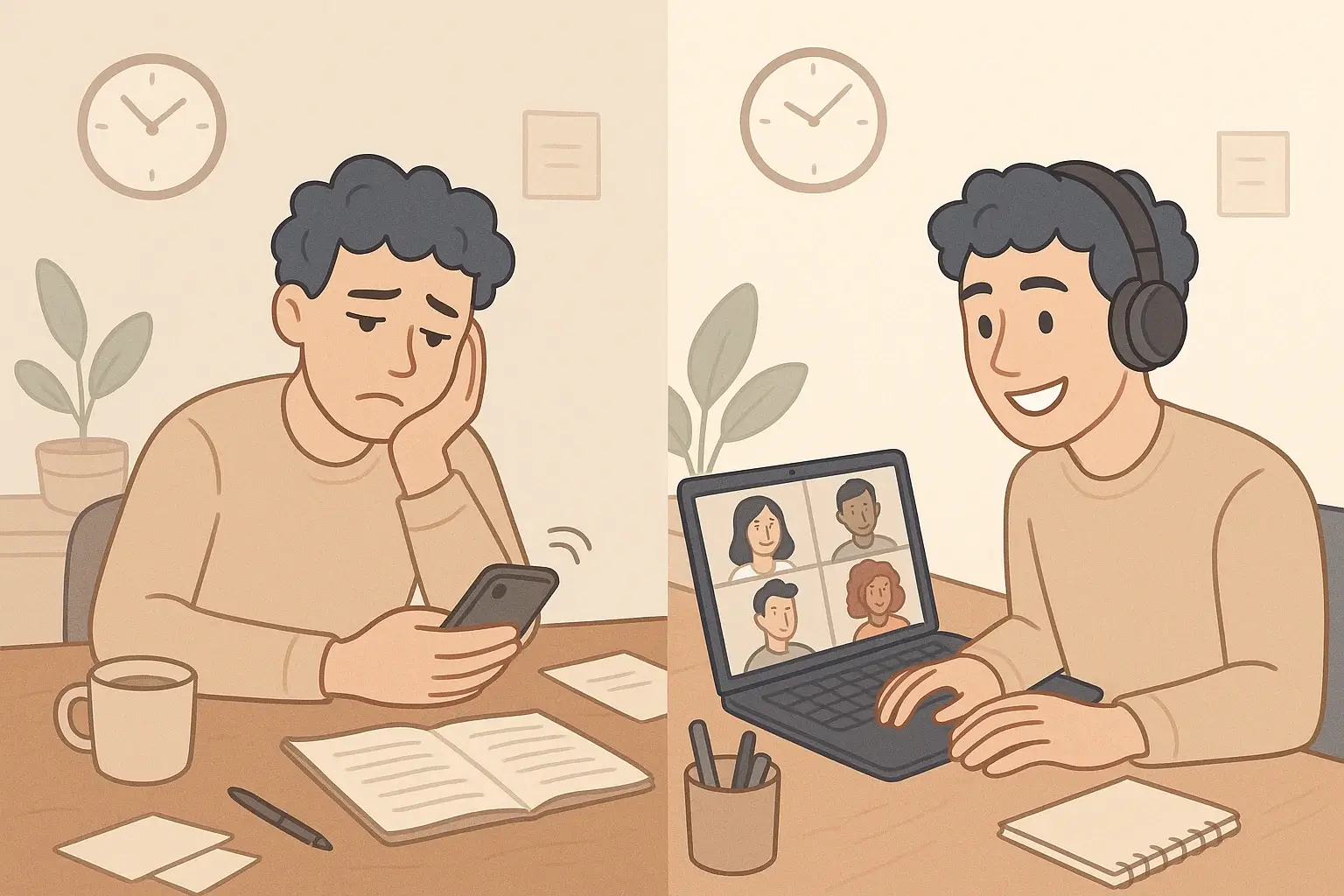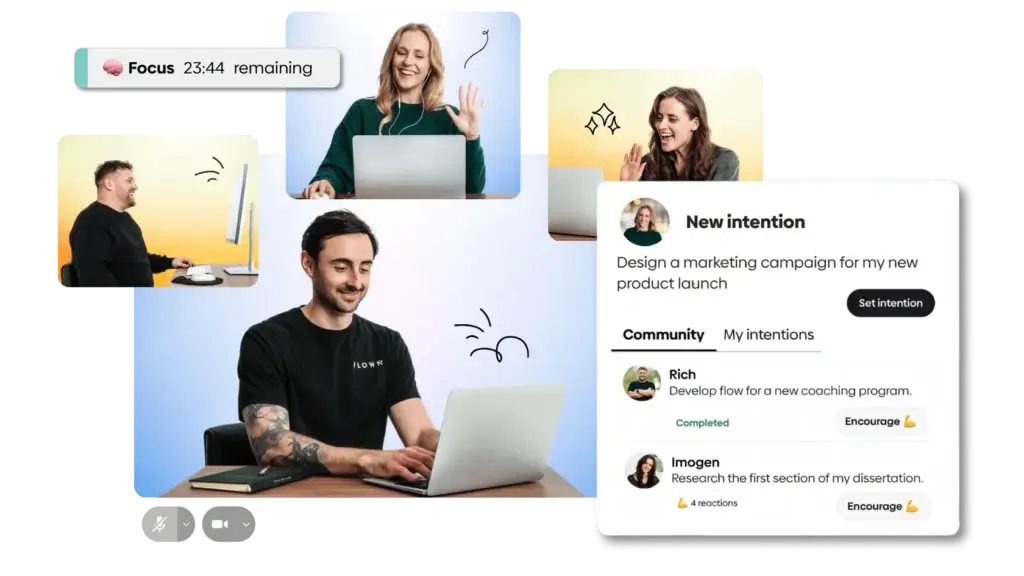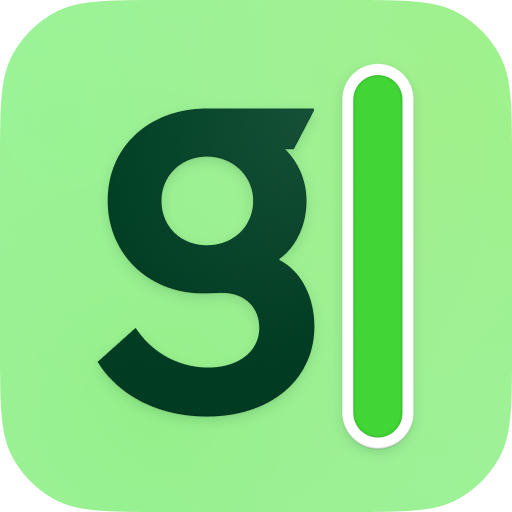
Introduction – The Rise of Virtual Coworking
When working remotely, distractions are just a click away. Between Slack messages, never-ending tabs, and the allure of your phone, staying focused can feel like a battle you’re destined to lose. That’s where virtual coworking comes in – a modern solution for a very modern problem.
More and more professionals are turning to virtual coworking as a way to recreate the structured environment of an office without leaving home. It’s not just about shared calendars or Zoom check-ins. These are real-time, silent, or guided focus sessions with others online – designed to help you work, not just talk about working.
Whether you’re a freelancer juggling client work, a developer needing deep focus, or someone managing ADHD symptoms, virtual coworking promises a boost in productivity, structure, and even motivation. But does it really work, or is it just another trend in the productivity space?
In this article, we’ll break down what virtual coworking is, the science behind why it can help, and whether it’s the right fit for your workflow. We’ll also look at the top platforms like FLOWN, Focusmate, and Groove, and offer practical tips to make the most out of your sessions.
Let’s explore whether virtual coworking is just digital noise or a powerful path to deeper focus.
What Is Virtual Coworking?
Virtual coworking is a digital practice where individuals work independently but alongside others in real-time, typically via video platforms. Think of it as a virtual version of a library or shared office, quiet, structured, and focused, but accessible from anywhere.
Definition and Origins
At its core, virtual coworking is designed to replicate the accountability and presence of in-person workspaces. Instead of physical desks and shared coffee machines, you join a live video session with others committed to deep work. You don’t collaborate on tasks; you simply work next to each other online.
The concept gained traction during the rise of remote work and the post-pandemic shift toward more flexible schedules. It builds on the idea of body doubling, a technique where the mere presence of another person helps you stay on task. While initially popular among neurodivergent communities (like those with ADHD), it has since gone mainstream among knowledge workers, creatives, and solopreneurs.
How Virtual Coworking Works
Most virtual coworking platforms follow a simple structure:
- You book or drop into a live focus session
- You’re matched with a partner or small group
- You briefly state your goal(s) for the session
- Everyone mutes their mic and works silently
- At the end, you check in to report progress
Some sessions are guided, featuring hosts who lead opening and closing rituals, play ambient music, or set a timer for focus sprints. Others are completely self-managed, simply providing a digital space where people show up and hold each other accountable.
Depending on the platform, you can:
- Join one-on-one sessions (like Focusmate)
- Enter community “deep work rooms” (like FLOWN)
- Participate in themed sprints (like Groove or Caveday)
This simple yet powerful framework offers both structure and flexibility, two key ingredients often missing from remote work environments.

The Psychology Behind Virtual Coworking
Virtual coworking isn’t just a trendy productivity hack, it’s rooted in well-established psychological principles that explain why working alongside others can sharpen your focus and boost motivation, even in a virtual setting.
Why It Helps You Focus
One of the key drivers behind virtual coworking is accountability through presence. When someone else is watching, or even just sharing the same virtual space, you’re more likely to stay on task. This taps into the social facilitation effect, a psychological phenomenon where people perform better when they know others are observing.
Even without interaction, knowing you’re being “seen” creates mild performance pressure, which can:
- Reduce procrastination
- Increase task initiation
- Improve attention span
Platforms like FLOWN and Focusmate leverage this effect by creating live, structured sessions where everyone is expected to show up, share intentions, and follow through.
Another concept at play is implementation intention, a behavioral strategy where publicly stating your goal makes you more likely to complete it. Saying “I’m going to write two pages” at the start of a coworking session gives your brain a clear directive, increasing follow-through.
Mental Benefits Beyond Focus
Beyond improved productivity, virtual coworking can have a positive psychological impact, especially for remote workers, freelancers, or anyone feeling isolated:
- Reduces loneliness: Regular sessions provide social connection without the drain of full meetings.
- Creates routine: Repeating structured work blocks helps train your brain for deep work.
- Improves mental well-being: Feeling part of a shared goal reduces anxiety, especially when tackling overwhelming tasks.
For neurodivergent individuals, especially those with ADHD, virtual coworking mimics body doubling, a practice where simply working near another person increases focus and task completion. This technique is now recognized as a powerful non-medical strategy for managing attention-related challenges.
Does Virtual Coworking Really Boost Productivity?
The short answer: yes, for many people, it does. But to fully understand why virtual coworking can be effective, it helps to look at both the research and the real-world experiences behind it.
Evidence from Studies and Research
While virtual coworking is still a relatively new phenomenon, it builds on decades of psychological research about focus, attention, and social influence.
Here’s what the data tells us:
- People are more likely to complete tasks when someone is watching, even passively. This is due to the social accountability effect.
- Structured routines and time-blocking improve productivity, especially when combined with publicly stated intentions. Virtual coworking incorporates both elements.
- According to a 2021 survey by Focusmate, over 90% of users reported an increase in task completion after one week of use. FLOWN has also reported anecdotal data showing users get significantly more done in “Flocks” (their live coworking sessions) than when working alone.
These outcomes align with the findings of behavioral scientists like Dr. BJ Fogg and Dr. Roy Baumeister, who have shown that external structure, goal setting, and presence can dramatically influence personal productivity.
Real-World Anecdotes and Case Studies
Beyond the numbers, the impact of virtual coworking is felt in the routines and stories of real users:
- Freelancers and solopreneurs report feeling less overwhelmed and more “mentally anchored” during virtual coworking sessions, helping them tackle tasks they would otherwise delay.
- Remote team members use these sessions to create shared momentum, especially across time zones, without needing constant meetings.
- Neurodivergent professionals, including those with ADHD, say the simple act of logging in and working beside others makes it significantly easier to start and stay on track.
One user shared:
“I use FLOWN for their morning deep work sessions, and I finish in 90 minutes what used to take me half a day. Just knowing someone else is working quietly with me keeps me honest.”
Another described Focusmate as their “anti-procrastination switch.”
While virtual coworking may not work for every personality type, there’s growing qualitative and quantitative support that it can elevate your productivity, especially for solo or remote work.
Pros and Cons of Virtual Coworking
| Pros ✅ | Cons ❌ |
| Boosts focus via accountability | May feel awkward at first |
| Reduces isolation and burnout | Time zone scheduling issues |
| Helps with ADHD and task initiation | Not suitable for all work types |
| Creates structure and routine | Limited networking interaction |
Like any productivity strategy, virtual coworking has its strengths and limitations. Whether it becomes a game-changer or a short-term experiment depends on your work style, preferences, and goals.
Pros ✅
-
Enhanced focus through accountability
Sharing your goals and being “seen” while you work encourages follow-through and reduces procrastination. -
Built-in structure and routine
Scheduled sessions help create a consistent rhythm in your workday, especially useful for remote professionals. -
Reduced loneliness and isolation
Virtual coworking provides passive social interaction, helping you feel connected without the pressure of conversation. -
Low-pressure motivation boost
Unlike meetings, there’s no need to perform; just show up, state your goal, and work quietly alongside others. -
Great for task initiation
Especially helpful for people with ADHD or task paralysis, the presence of others lowers the friction of getting started.
Cons ❌
-
May feel awkward at first
Working silently on camera with strangers can feel uncomfortable until you get used to it. -
Time zone and scheduling challenges
Not all platforms offer 24/7 sessions, so finding consistent slots may require planning. -
Limited interaction or networking
Most virtual coworking sessions focus on quiet work, not collaboration or socializing. -
Not ideal for all tasks
Creative brainstorming or meetings still require separate spaces, coworking works best for focused solo work.
Best Virtual Coworking Platforms to Try
If you’re curious to test virtual coworking, several platforms make it easy to get started. Each one offers a different experience; some focus on deep, silent work, while others emphasize community and sprints.
Here are four of the most popular virtual coworking tools worth exploring:
FLOWN – Deep Work With Community
Best for: Creatives, freelancers, and remote professionals seeking structure and accountability
FLOWN is built around the science of deep work. It offers live video “Flocks” (guided focus sessions), deep work rooms, journaling prompts, and even breathwork sessions. Unlike more minimalist platforms, FLOWN blends productivity with wellness, helping you maintain focus without burning out.
- Hosted sessions with friendly facilitators
- Sessions range from 20 to 90 minutes
- Built-in reflection and intention-setting
- Active global community and resources
- Premium subscription model, free trial available

Focusmate – One-on-One Accountability
Best for: Solo professionals who need silent accountability on demand
Focusmate connects you with a live accountability partner for a 25- or 50-minute session. You share your goals at the beginning, work silently on camera, and check in at the end. It’s ultra-minimal, making it great for repeat daily sessions.
- 1:1 video coworking in real time
- Available 24/7 across time zones
- First 3 sessions per week are free
- Ideal for writers, developers, and students
Groove – Work in Casual Founder Circles
Best for: Entrepreneurs, indie makers, and startup founders
Groove takes a more casual, community-first approach. You join a small group of 3–5 people working independently in 50-minute focus sprints. There’s a social aspect, with Slack-based intros and post-session reflections, making it ideal for solo founders looking for motivation and connection.
- Focus sprints via Zoom in small peer groups
- Community vibe with light networking
- Free to use, paid options coming soon
- Great for light accountability and momentum
Caveday – Facilitated Focus Sprints
Best for: Those who want a rigorous structure and full immersion
Caveday provides facilitator-led deep work sessions with strict rules: cameras on, phones away, and full immersion in the task. It’s like a virtual productivity bootcamp and best suited to people who thrive in high-accountability environments.
- Sessions range from 1 to 3 hours
- “Deep Caves” for intensive workdays
- Live hosts guide you in and out of focus
- Paid membership, with free trial sessions
With so many platforms available, it can be tough to decide which virtual coworking tool fits your workflow best. Below is a side-by-side comparison of the top platforms, including the type of sessions they offer, who they’re best suited for, and whether they include guided support or free plans:
| Platform | Session Type | Best For | Guided? | Free Plan |
| FLOWN | Group deep work | Creatives & professionals | Yes | Trial only |
| Focusmate | 1-on-1 sessions | Solo workers & freelancers | No | Yes (3 sessions/week) |
| Groove | Small group sprints | Startup founders | No | Yes |
| Caveday | Facilitated sessions | Deep focus users | Yes | Trial only |
Tips for Getting the Most Out of Virtual Coworking
If you’re ready to try virtual coworking, a few simple strategies can maximize its effectiveness and help you turn it into a productive habit, not just a one-off experiment.
Set Clear Goals Before Each Session
Don’t just show up, know what you want to achieve. Even a short sentence like “Finish two slides” or “Reply to all client emails” gives your brain direction. This taps into implementation intention, which increases follow-through.
-
Tip: Write your goal on a sticky note or in the session’s chat.
Choose the Right Platform for Your Style
Each coworking platform caters to different needs. If you like structure, choose hosted or guided sessions like FLOWN or Caveday. Prefer silence and flexibility? Try Focusmate or Groove. The best platform is the one you’ll use consistently.
-
Tip: Test a few platforms during a free trial week to see what sticks.
Eliminate Distractions Before You Begin
You’ll get the most out of each session by protecting your environment. Silence notifications, close unnecessary tabs, and put your phone out of sight.
-
Tip: Use tools like Forest or Freedom to block distracting sites during sessions.
Create a Ritual Around Your Sessions
Starting each session with a short ritual, like setting intentions or lighting a candle, signals to your brain that it’s time to focus. Over time, these cues strengthen your ability to enter a deep work state more quickly.
-
Tip: Try starting sessions with a 30-second breathing exercise or stretching.
Track Your Results and Reflect
At the end of each session, take 1 minute to reflect: What did I accomplish? What can I improve? This reinforces progress and builds motivation for your next session.
-
Tip: Keep a simple coworking journal or use a habit tracker app.
Final Thoughts – Is It Worth Trying?
So, does virtual coworking really boost productivity?
For many people, the answer is a resounding yes. Whether you’re fighting procrastination, working solo from home, or simply craving structure in your day, virtual coworking offers a unique combination of accountability, focus, and low-pressure support.
What makes it powerful isn’t just the technology; it’s the psychology. By tapping into social presence, goal-setting, and time-blocking, these platforms help you overcome inertia and get into the flow of meaningful work.
That said, it’s not one-size-fits-all. Some thrive in silent solo spaces, while others need guided structure or a visible community. The best way to find out? Try a few sessions. Many tools offer free plans or trials, so there’s little to lose and a lot of focus to gain.
If you’re serious about deep work, virtual coworking can be a simple but transformative tool in your productivity stack.
Looking for more ways to improve your focus and workflow? Explore our Top To-Do list apps to complement your coworking sessions.
FAQs
What is virtual coworking?
Virtual coworking is a live, online session where people work independently but together in real time, often via video. It’s designed to improve focus, accountability, and productivity by recreating the presence of others in a remote setting.
How does virtual coworking improve productivity?
It uses social accountability and structured time blocks to reduce distractions and help you stay focused. Sharing your goals and working alongside others encourages task completion and reduces procrastination.
Is virtual coworking helpful for ADHD?
Yes, many people with ADHD find it effective because it mimics body doubling, a technique that helps with task initiation and focus by working near someone else, even virtually.
Do I have to talk during virtual coworking sessions?
Most sessions are silent, with only brief check-ins at the start and end to share goals. Some platforms offer guided sessions, but you’re never required to speak if you prefer not to.
Can I use virtual coworking for creative work?
Absolutely. It’s great for writing, designing, coding, or any solo creative task that requires concentration. It helps create the mental space needed for deep work.
Which tools are best for virtual coworking?
Popular platforms include FLOWN, Focusmate, Groove, and Caveday. Each offers different session styles, from one-on-one to guided group focus rooms.
Is virtual coworking free to use?
Some platforms offer free plans or limited free sessions each week. Others operate on monthly subscriptions, but often include free trials so you can test them out.
Can teams use virtual coworking?
Yes. While it’s commonly used individually, some teams use it to create shared focus time, improve remote team morale, or keep each other accountable in a non-intrusive way.
How long are virtual coworking sessions?
Sessions typically range from 25 minutes (Pomodoro-style) to 90-minute deep work blocks. Many platforms let you choose the session length that suits your task.
How do I stay consistent with virtual coworking?
Treat it like an appointment, add it to your calendar, prepare your task list beforehand, and track your results. Consistency builds routine, and routine builds momentum.






